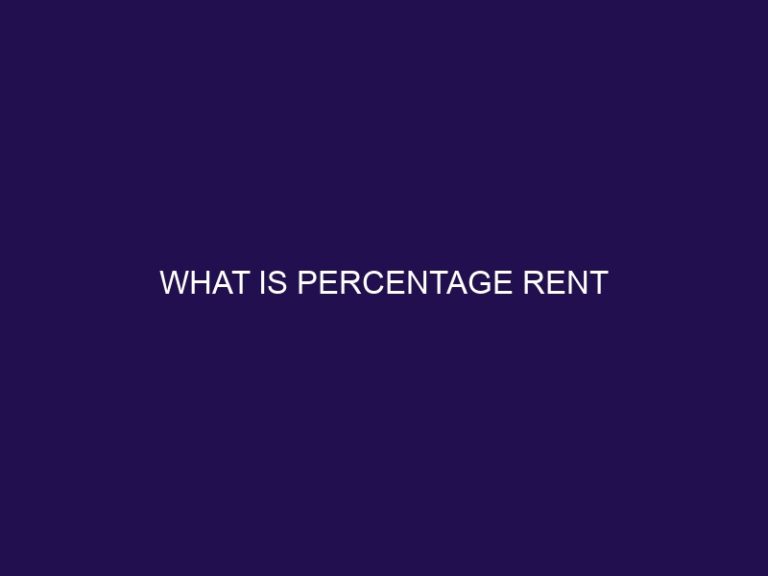What is Market Rent
Market rent plays a crucial role in the real estate industry, both for landlords and tenants. Understanding what market rent is and how it is determined is essential for making informed decisions related to rental properties. Market rent refers to the prevailing rental rate for a particular property in the current market conditions. It is the amount that a landlord can reasonably charge and that tenants are willing to pay for a property. Several key factors influence market rent, such as location, property amenities, supply and demand, economic conditions, and tenant demographics. Determining fair market rent involves conducting market research, analyzing comparable properties, and considering local rental market trends. By understanding market rent, both landlords and tenants can navigate the rental market effectively and make informed decisions regarding rental prices and agreements.
Understanding Market Rent
Understanding market rent is crucial for both landlords and tenants. Market rent refers to the current rental rate in a specific location and for a particular type of property. Several factors, such as the property’s location, size, condition, and demand in the area, influence market rent. Landlords rely on understanding market rent to determine how much to charge for their rental units, while tenants use this information to assess whether the price is fair and competitive. By comprehending market rent, both parties can effectively negotiate leases and ensure that the rental rate aligns with the current market conditions.
What is Market Rent?
Discover the intriguing world of market rent as we unravel its meaning and delve into the key factors that influence this essential concept. Brace yourself as we explore the definition of market rent and uncover the pivotal elements that shape its dynamics. Get ready to gain insights into this fundamental aspect of the real estate market, backed by reputable sources and noteworthy statistics. Let’s dive in!
Definition of Market Rent
Definition of Market Rent refers to the amount of money that a property can be rented for in the current market conditions. It is determined based on factors like location, amenities, property characteristics, and tenant demographics. Landlords use Definition of Market Rent to set the price for their rental properties, while tenants use it to determine if the rent is fair. Factors that can affect Definition of Market Rent include supply and demand, economic conditions, and property location. To determine fair market rent, individuals can work with real estate professionals, use online resources, and understand local rental market trends.
In history, the concept of Definition of Market Rent has been used for centuries, as people have always leased properties for various purposes. It has evolved over time to accommodate changing economic and societal conditions.
Key Factors Influencing Market Rent
- Key factors that influence market rent include:
- Location: Properties in desirable areas with high demand tend to have higher rents.
- Amenities: Properties with desirable features, such as swimming pools or fitness centers, can command higher rents.
- Property size and layout: Larger or more spacious properties generally have higher rents.
- Property condition: Well-maintained properties with modern amenities can justify higher rents.
- Supply and demand: When there is a shortage of rental properties, rents tend to increase.
- Proximity to transportation options: such as subway stations or bus stops, can also have a significant impact on market rent.
How is Market Rent Determined?
Discover the secrets behind determining market rent in this insightful section. Uncover the power of market research and analysis, as well as how a comparison of similar properties can influence rental rates. Plus, explore the significance of location and amenities when determining market rent. With a blend of data-driven insights and practical considerations, you’ll gain a deeper understanding of the factors that shape this crucial aspect of the rental market. Get ready to dive into the fascinating world of market rent determination!
Market Research and Analysis
Market research and analysis is an essential step in determining market rent for a property. Here are some key factors to consider:
- Demand and supply: Conduct market research and analysis to evaluate the current demand for rental properties in the area and compare it with the supply available.
- Economic conditions: Assess the local economy’s performance, including factors like job growth, population growth, and overall market stability, as part of the market research and analysis process.
- Property location: During market research and analysis, evaluate the desirability of the location, taking into account factors such as proximity to amenities, transportation options, and school districts.
- Property characteristics: Consider the size, condition, and features of the property during market research and analysis, as well as any unique selling points that may influence market rent.
- Tenant demographics: As part of the market research and analysis, gain an understanding of the target renter demographic and their preferences, such as the type of property they are looking for and the rental rates they are willing to pay.
Comparison of Similar Properties
| Comparison of Similar Properties | |||||
| When comparing similar properties to determine market rent, several factors should be considered. Here is a comparison table showcasing important elements: | |||||
| Property | Size (sq ft) | Location | Condition | Amenities | Rental Price |
| Property 1 | 1000 | Downtown | Excellent | Gym, pool | $2000 |
| Property 2 | 900 | Suburb | Good | No amenities | $1500 |
| Property 3 | 1100 | City center | Excellent | Roof deck | $2200 |
To determine fair market rent, consider these suggestions: analyze data from recently rented properties, consult with local real estate professionals, and monitor current rental market trends. Remember that pricing should be competitive, taking into account the location, condition, and amenities offered.
Consideration of Location and Amenities
Incorporating consideration of location and amenities is crucial when determining market rent for a property.
- Location: Properties in desirable locations, such as city centers or near amenities like schools and shopping centers, can command higher market rents.
- Amenities: Properties with attractive amenities like gyms, pools, or parking spaces can justify higher rental prices.
- Accessibility: Easy access to public transportation or major highways can also affect market rent.
- Demographics: Consider the target demographic for the property and tailor the amenities and location accordingly.
When setting market rent, it’s essential to carefully assess the location and amenities to ensure competitive pricing that attracts tenants and maximizes rental income.
Why is Market Rent Important?
Discover the significance of market rent and why it holds immense importance. Peek into the perspectives of both landlords and tenants as we unravel the reasons behind its value. Gain insights into the benefits, facts, and events surrounding market rent that makes it an essential aspect of the real estate world.
For Landlords
Selecting an appropriate market rent is crucial for landlords to maximize their rental income and attract reliable tenants. Here are some factors that landlords should consider to ensure they set competitive prices and maximize their rental income:
- Market research: Conducting thorough market research helps landlords understand rental rates in their area, enabling them to determine the most suitable market rent for their properties.
- Property condition: The condition and amenities of the property play a significant role in determining market rent. Well-maintained properties with desirable features can command higher rents, making them more appealing to potential tenants.
- Location: The location of the property greatly impacts market rent potential. Properties in high-demand areas or those situated close to amenities like schools, parks, and transportation tend to have higher rent potential. Landlords should take this into consideration when setting their rental prices.
- Supply and demand: Understanding the supply and demand dynamics of the local rental market is essential for landlords. By assessing market conditions, landlords can determine whether it is possible to command higher rents or if adjustments to their pricing strategy are necessary.
- Comparable properties: It is crucial for landlords to compare their property to similar ones in the area. This comparison allows landlords to gauge the market rent range and ensure their pricing is competitive. By doing so, they can attract reliable tenants and maximize their rental income.
Considering these factors, landlords can make informed decisions about setting market rent, ultimately maximizing their rental income and attracting reliable tenants.
For Tenants
As tenants, understanding market rent is crucial for making informed decisions about renting a property. For tenants, here are some key points to consider:
- Market rent determines the fair price for a rental property based on factors such as location, amenities, and demand.
- It allows tenants to assess if the rent they are paying is in line with the current market rates.
- Knowing market rent helps tenants negotiate lease terms and ensure they are not overpaying for a property.
- Factors that can affect market rent for tenants include supply and demand, economic conditions, property location, characteristics, and tenant demographics.
Being aware of market rent empowers tenants to make financially sound choices when renting a property.
As a historical example, in the late 19th century, tenants in the crowded tenement buildings of New York City’s Lower East Side often faced exorbitant rents and inadequate living conditions. It was the efforts of tenant organizing groups like the Tenement House Committee that led to landmark legislation, such as the Tenement House Act of 1901, which improved housing conditions and imposed regulations on landlords, ultimately benefiting tenants.
Factors That Can Affect Market Rent
When it comes to market rent, certain factors can have a significant impact. From supply and demand dynamics to economic conditions, property location, characteristics, and even tenant demographics, each aspect plays a vital role in determining market rent. In this section, we’ll dive into these key factors, shedding light on how they influence rental rates and shape the overall rental market. So, let’s explore the intricate web of elements that can sway market rent and gain a better understanding of this complex landscape.
Supply and Demand
Supply and demand play a crucial role in determining market rent. The table below highlights how these factors impact the rental market:
| Supply Factors | Demand Factors |
|---|---|
| Number of available units | Population growth |
| New construction projects | Job opportunities |
| Rental property vacancies | Influx of students |
| Rent control regulations | Lifestyle preferences |
| Housing market conditions | Income levels |
The balance between supply and demand influences market rent prices significantly. When there is an excess supply of rental units, landlords may lower rent to attract tenants. Conversely, when the demand for rental properties surpasses the available supply, landlords can charge higher rents. It’s essential for both landlords and tenants to comprehend these dynamics to make informed decisions in the rental market.
Economic Conditions
Economic conditions play a crucial role in determining market rent. Changes in the overall economy, such as inflation, GDP growth, and interest rates, can have a significant impact on the demand for rental properties and the ability of tenants to afford higher rents. During periods of economic downturns, characterized by high unemployment rates and limited disposable income, landlords may encounter difficulties in raising rent prices. Conversely, during times of economic prosperity, marked by low unemployment rates and increased disposable income, landlords may possess more bargaining power to establish higher rental rates. It is imperative for both landlords and tenants to stay informed about economic conditions in order to make well-informed decisions regarding market rent.
Property Location
Selecting the proper location for a property is of utmost importance when determining market rent. The location of a property can significantly influence its rental value and appeal to potential tenants. Factors such as proximity to amenities, transportation options, safety, and the desirability of the neighborhood all contribute to establishing market rent. Properties situated in prime areas with high demand are likely to command higher rental prices, while those in less desirable locations may have lower rental values. Both landlords and tenants should take into account the property’s location when deciding on fair market rent for a successful renting experience.
Property Characteristics
Property characteristics play a crucial role in determining the market rent. Different features of a property have the potential to influence its rental value. Here are some crucial property characteristics that impact market rent:
| 1. Size: | The square footage of a property is an essential factor in determining its rent. Larger properties typically demand higher rents. |
|---|---|
| 2. Amenities: | Properties with desirable amenities such as swimming pools, fitness centers, or parking facilities have a tendency to fetch higher rents compared to those without such features. |
| 3. Condition: | The overall condition of a property, including its maintenance and upgrades, can have an impact on its rental value. Well-maintained properties often demand higher rents. |
| 4. Location: | The location of a property, including its proximity to essential services, transportation options, and desirable neighborhoods, can significantly affect market rent. |
| 5. Layout and Design: | The layout and design of a property can influence its appeal to potential tenants. Properties with functional and attractive layouts are often more desirable and can demand higher rents. |
Considering these property characteristics is crucial for both landlords and tenants in determining fair market rent. Landlords can utilize these factors to establish competitive rental prices, while tenants can evaluate whether a property offers good value based on its characteristics.
Tenant Demographics
Tenant demographics, also known as tenant characteristics, play a crucial role in determining market rent. Understanding the demographics of potential tenants in a specific area is essential for landlords to set appropriate rental prices. Factors such as average income, age range, family size, and lifestyle preferences of the target tenant group need to be taken into consideration. For instance, if a neighborhood has a high percentage of young professionals with higher incomes, landlords can justify charging higher rents for properties in that area. Conversely, if the local demographic consists mainly of low-income families, landlords may need to adjust rent prices accordingly in order to attract tenants. By having knowledge of tenant demographics, landlords are able to make informed decisions and better cater to the needs of their target market.
To exemplify the impact of tenant demographics, let’s look at a property owner in the bustling city of New York. Recognizing the increasing number of young professionals moving to the area, this owner decided to analyze tenant demographics. Through this analysis, she discovered that many of these professionals valued convenience and desired modern, upscale apartments. Armed with this valuable information, she made the strategic decision to invest in renovating her properties, creating sleek and contemporary living spaces with amenities tailored to the needs of this specific demographic. The result? She was able to set higher market rent prices and effortlessly attract tenants within this demographic, ultimately leading to a substantial increase in her rental income.
How to Determine Fair Market Rent?
When it comes to determining fair market rent, it’s essential to consider various factors. In this section, we’ll explore different approaches to help you navigate this process smoothly. From working with real estate professionals who provide expert insights to using online resources for valuable data, to understanding the fluctuating trends in the local rental market, we’ll equip you with the knowledge you need to make informed decisions. So let’s dive in and discover the best ways to determine fair market rent!
Working with Real Estate Professionals
Collaborating with real estate professionals is crucial when assessing market rent. These specialists possess extensive knowledge about the local rental market trends and can offer valuable insights on the appropriate fair market rent rates. They can evaluate the characteristics of your property and compare it to similar properties within the vicinity, carefully considering factors such as location and amenities. Moreover, real estate professionals have access to online resources and market research tools that aid in determining an accurate market rent value. With their expertise and guidance, both landlords and tenants can make well-informed decisions when establishing or negotiating rent prices. They assist landlords in attracting reputable tenants and aid tenants in finding suitable and reasonably priced rental properties.
Using Online Resources
Using online resources can be a valuable tool in determining fair market rent for both landlords and tenants. Here are some ways to effectively utilize online resources to gather this information:
- Browse through rental listing websites to compare similar properties in the area and their associated rental prices.
- Take advantage of rental market analysis tools that provide data on rental trends and average rental rates for specific locations.
- Engage in online forums or communities where landlords and tenants share insights and experiences about rental prices in the area.
- Explore websites that offer rental price calculators, which can provide estimates based on factors such as location, property size, and amenities.
- Examine online market reports and studies that offer comprehensive data on rental market conditions and fluctuations.
By utilizing these online resources, individuals can gain valuable information and make well-informed decisions when determining fair market rent.
Understanding Local Rental Market Trends
Understanding local rental market trends is essential for both landlords and tenants. By keeping themselves informed about the rental market in their area, landlords can competitively price their properties and attract high-quality tenants. In contrast, tenants can utilize market trends to negotiate favorable rental terms. To comprehend local rental market trends, landlords and tenants can gather information from real estate professionals, online resources, and by analyzing historical rental data. For instance, in a popular college town, a landlord might observe an increased demand for smaller, affordable apartments due to a surge in the student population. Similarly, a tenant searching for a rental in a trendy neighborhood might discover a consistent rise in rental prices over the past few years. Understanding local rental market trends empowers both landlords and tenants to make informed decisions and accomplish their goals in the rental market.
Sarah, a landlord in a suburban area, recently made the decision to rent out her vacant property. She conducted extensive research and found that the local rental market had a high demand for family-friendly homes with spacious yards. Based on this trend, Sarah decided to enhance her property by installing a new playground in the backyard. Within a week of listing her property, Sarah received multiple inquiries and was able to rent it out at a higher rate than she initially expected. Sarah’s understanding of the local rental market trends enabled her to attract quality tenants and maximize the rental income from her property.
Frequently Asked Questions
What is market rent?
Market rent refers to the anticipated monthly rent for a specific property type, determined by the U.S. Department of Housing and Urban Development (HUD). It is used in government housing programs, such as the Section Eight Housing Choice Voucher Program, to calculate standardized rental rates for low-income individuals.
How is market rent used in federal housing assistance programs?
Market rent plays a crucial role in federal housing assistance programs by setting the limit on what units can be rented and determining the subsidy provided to households. Section Eight households cannot rent units with a gross rent that exceeds the market rent, and they receive a subsidy equal to the difference between the market rent and 30 percent of their incomes.
Why is market rent important for landlords and rental property investors?
Market rent helps landlords and rental property investors determine appropriate rent pricing, maintain positive cash flow, and assess the potential rental income of a property. Comparing rental prices of similar properties can give an idea of what to charge tenants and assess cash flow potential. It also helps investors determine if a rental property will generate consistent profit.
How does market rent impact the availability of affordable housing for low-income households?
Market rent primarily functions to control costs in federal housing assistance programs. Higher market rents would mean higher costs per Section Eight household and fewer households being assisted due to a fixed budget. It is important to ensure an adequate supply of decent, safe, and sanitary rental units at or below market rent to meet the needs of low-income households.
What is the difference between market rent and subsidized rent?
Market rent refers to apartments rented through private landlords at market rates, whereas subsidized rent is based on income and allows tenants to pay rent that is less than market rent. In subsidized housing, the local housing authority or HUD pays the remaining portion of the rent based on the household’s income.
How can landlords benefit from knowing the local fair market rent?
Knowing the local fair market rent can help landlords make informed decisions about rent pricing. It can assist in determining whether to raise rents or to prevent charging too little. This knowledge can help maintain favorable cash flow, cover expenses like property taxes, and attract good tenants.







